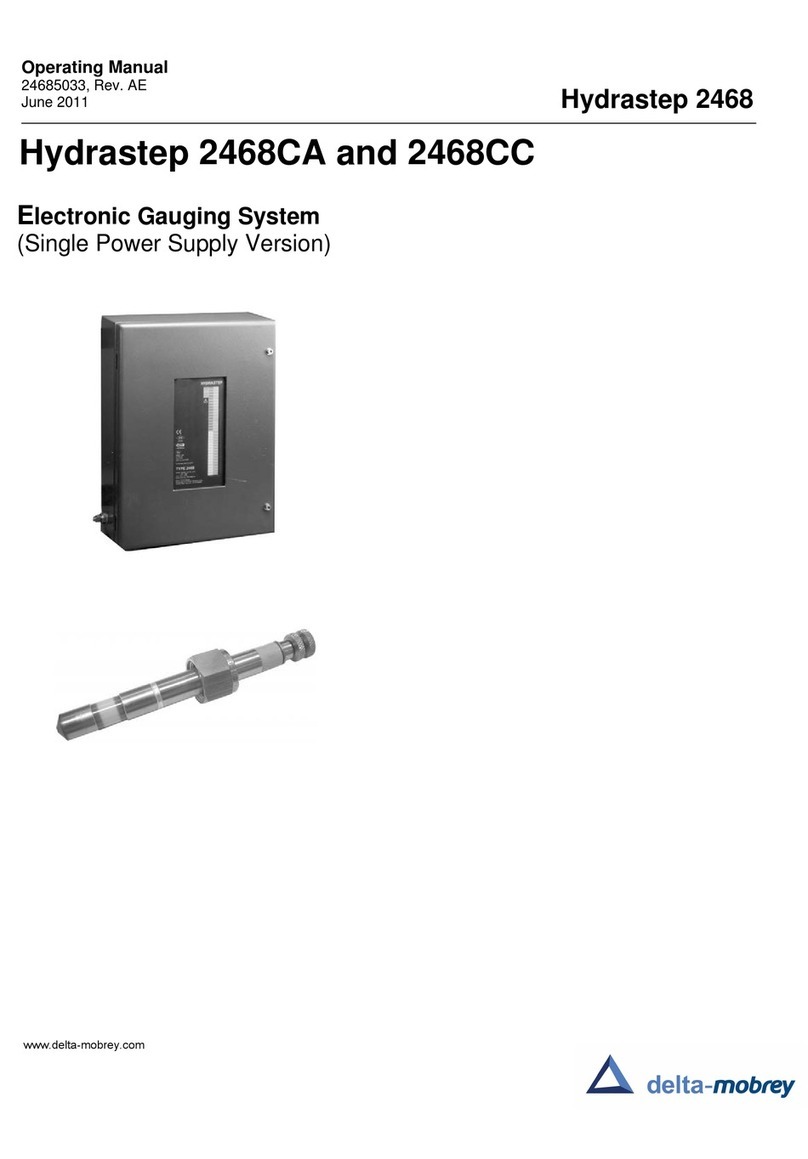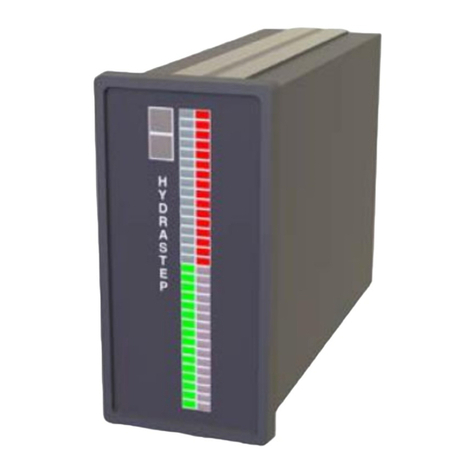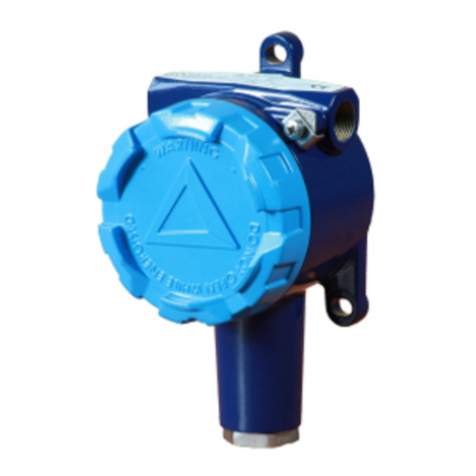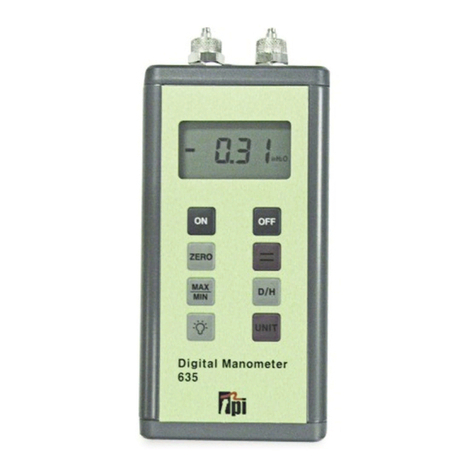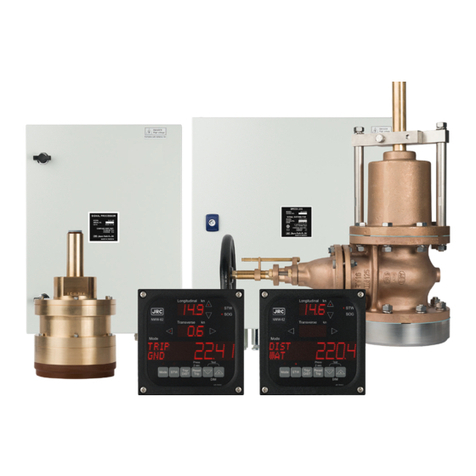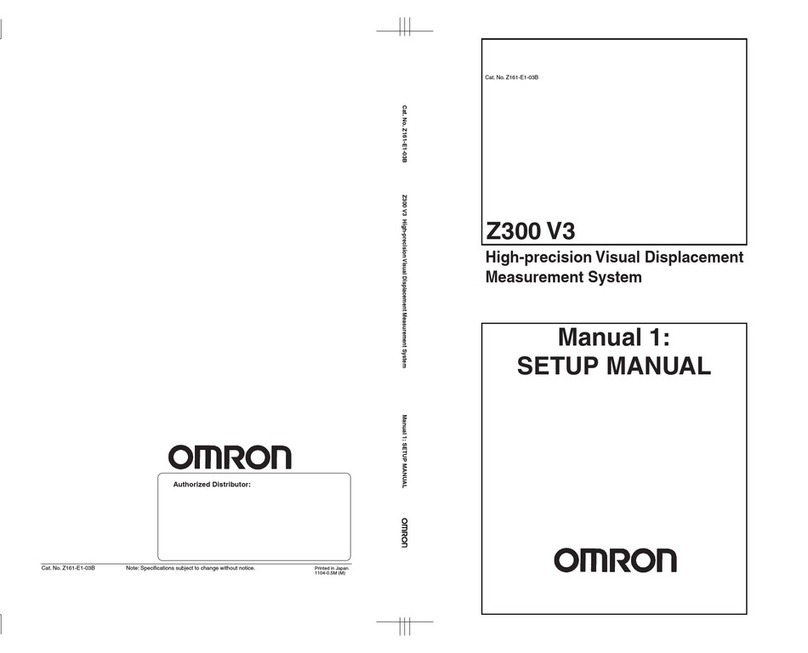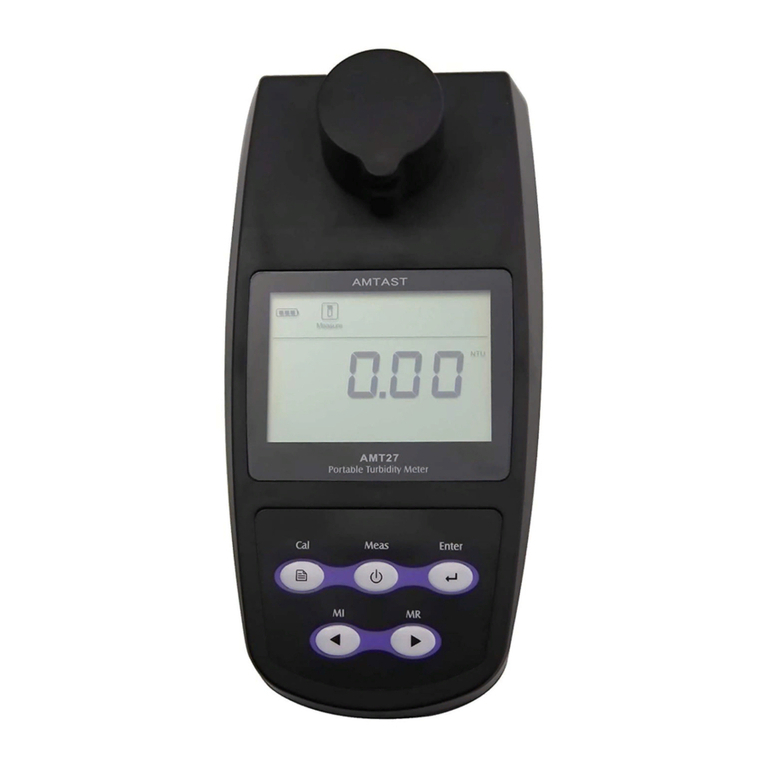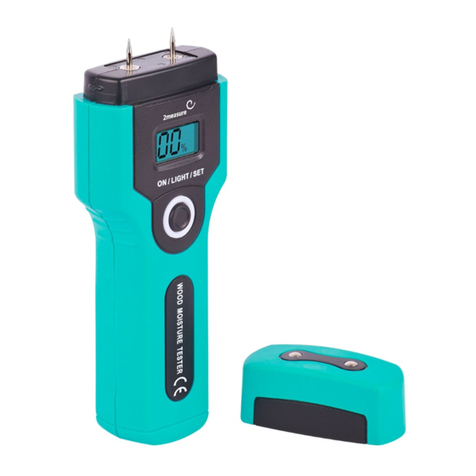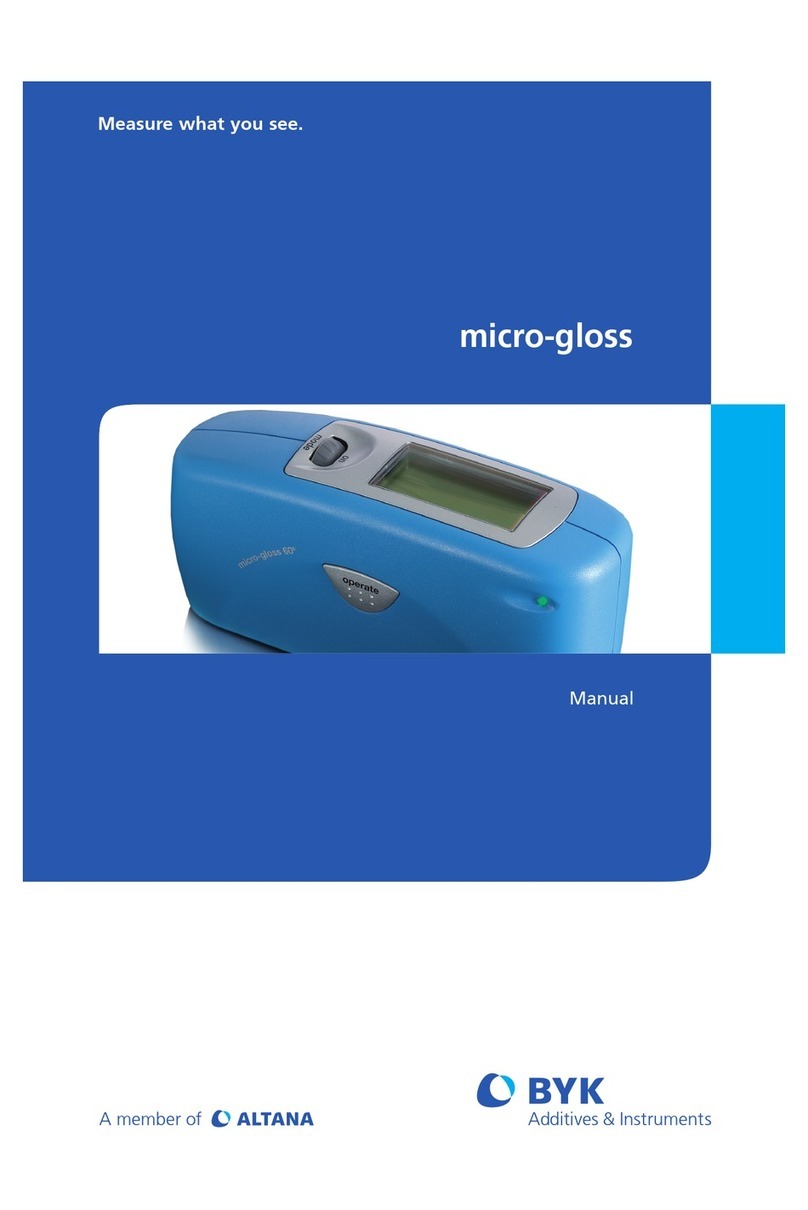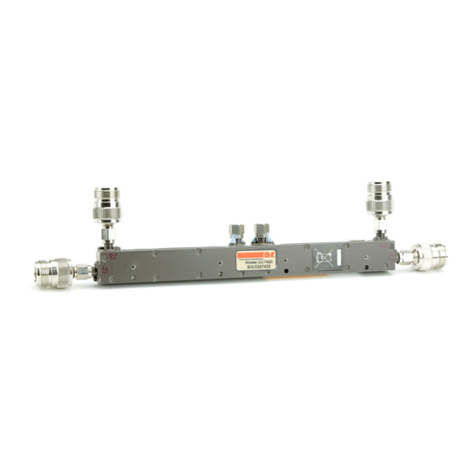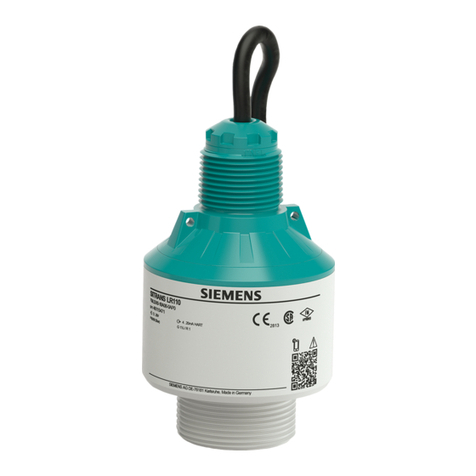delta-mobrey Mobrey MCU200 Series User manual

Installation and Operating Manual
IP227, Rev DA
Mobrey MCU200 Series
February 2020
Mobrey™Ultrasonic Liquid Level Detection
Systems for Interface Applications
User Manual
Control unit types:
MCU201 and MCU203
Ultrasonic gap sensor types:
433SD, 402SD, and 442SD

2
Installation and Operating Manual
IP227, Rev DA
Mobrey MCU200 Series
February 2020
General safety precautions
The equipment described in this manual has been designed in accordance with EN61010 “Safety requirements for
electrical equipment for measurement, control and laboratory use”, and has been supplied in a safe condition.
To avoid injury to an operator or service technician, the safety precautions given below, and throughout the
manual, must be strictly followed whenever the equipment is operated, services or repaired.
For specific safety details, please refer to the relevant sections within the manual.The equipment is designed solely
for electronic measurement and should be used for no other purpose. Delta Mobrey accepts no responsibility for
accidents or damage resulting from failure to comply with these precautions.
Grounding
To minimise the hazard of electrical shock, it is essential that the equipment be connected to a protective ground
whenever the power supply, measurement or control circuits are connected, even if the equipment is switched off.
The electronics unit must be connected to ground using the marked case stud before control or signal leads are
connected. The ground connections must have a current rating of 25 A.
AC supply
Never operate the equipment from a line voltage or frequency in excess of that specified. Otherwise, the insulation
of internal components may break down and cause excessive leakage currents.To allow the electronics unit to be
isolated from the ac supply, the supply must be routed through a switch (or circuit breaker). The switch (or circuit
breaker) must be within easy reach of the operator and must be clearly identified as the means of supply isolation.
The maximum current drawn from the supply must be limited by a fuse or trip, to a maximum of 13 A.
Fuses
Before switching on the equipment, check that the fuses accessible from the interior of the equipment are of the
correct rating. The rating of the ac line fuse must be in accordance with the voltage of the ac supply. If any fuse
continually blows, do not insert a fuse of a higher rating. Switch the equipment off, clearly label it “unserviceable”
and inform a service technician.
Explosive atmospheres
Never operate the equipment, or any sensors connected to the equipment, in a potentially explosive atmosphere.
It is not intrinsically safe and could possibly cause an explosion.
Safety symbols
For the guidance and protection of the user, the following safety symbols appear on the equipment:
Symbol: Meaning:
Fault indicator. Refer to the user manual for detailed instructions of use.
Hazardous voltages

3
Installation and Operating Manual
IP277, Rev DA
Mobrey MCU200 Series
February 2020
Avoid unsafe equipment
The equipment may be unsafe if any of the following statements apply:
Equipment shows visible damage
Equipment has failed to perform an intended operation
Equipment has been subjected to prolonged storage under unfavourable conditions
Equipment has been subjected to severe physical stress.
Live conductors
Do not open the electronics unit when it is energised.
When the equipment is connected to its’ supply, the opening of covers or removal of parts could expose live
conductors. The equipment must be disconnected from all power and signal sources before it is opened for any
adjustment, replacement, maintenance or repair. Adjustment, maintenance and repairs must be must be done by
qualified personnel.
Equipment modification
To avoid introducing safety hazards, never install non-standard parts in the equipment, or make any unauthorised
modification. To maintain safety, always return the equipment to Delta Mobrey for service and repair.
If in any doubt as to the serviceability of the equipment, don’t use it. Get it properly checked out by a qualified
service technician.

4
Installation and Operating Manual
IP227, Rev DA
Mobrey MCU200 Series
February 2020
1. Introduction
Delta-Mobrey level control systems for sludge blanket and interface detection applications
require a Mobrey MCU200 Series control unit and a Mobrey ultrasonic sensor (Figure 1).
The start of this manual shows how to install the control unit and supported sensors to form
control systems. This is followed by application information for configuration and operation of
the control unit. Finally, there is the maintenance, spare parts, and specifications information.
Figure 1. Typical application with Mobrey 442SD and 402SD ultrasonic Gap Sensors
A. Mobrey MCU200 controller B. Mobrey 402SD sensor C. Mobrey 442SD sensor
2. Sensor installation
2.1 Safety matters
Review all the safety information at the front of this manual.
2.2 How ultrasonic gap sensors work
Each Mobrey ultrasonic sensor contains two piezoelectric crystals. A high frequency signal
(1 MHz or 3.7 MHz) is generated by the control unit and transmitted to one of the piezoelectric
crystals by coaxial cable. This crystal converts the electrical signal into an ultrasonic oscillation.
The sensor design allows the ultrasonic oscillation to pass from the transmitter crystal to the
receiver piezoelectric crystal (Figure 2) through a gap. When the gap is in liquid, the signal
reaches the receiver due to the low ultrasonic attenuation of the liquid. When the gap is filled
with air, no ultrasonic signal can pass from transmitter to receiver.
A
B
C

5
Installation and Operating Manual
IP277, Rev DA
Mobrey MCU200 Series
February 2020
Figure 2. Sensor in clear water and sludge
When the gap is filled with liquid, the piezoelectric receiver crystal converts the ultrasonic wave
into an electrical signal, which is transmitted back to the control unit using a second coaxial
cable. Usually the two coaxial cables to the sensor are in one overall sheath.
The control unit circuitry is a feedback amplifier, which oscillates when the sensor is wet and is
quiescent when the sensor is dry. The “oscillating” and “non-oscillating” sensor states
determine the output relay states of the control unit.
For sludge blanket or interface detection the sensor “oscillates” in a clear liquid and is “non-oscil-
lating” in the sludge or at the interface. An amplifier gain adjustment determines the sludge
density for the change between these two states. See “Interface detection” on page 12.
2.3 Switching levels and orientation
Mobrey gap sensors are mounted with the sensor faces vertical. This is to avoid a build-up of
solids on the sensor faces on either side of the gap. In this orientation, the switching level is
half-way up the sensor face. If the sensor is mounted from the side of the tank, the switching
level is normally on the centreline of the cylindrical body.
2.4 Installation of the sensor
The sensor must be handled with care - it is a measuring instrument. Before installation, check
that sensor, cable and control unit have not been damaged in transit. If necessary, drill and tap a
hole with a suitable thread. It is advisable to use a boss or similar on thin walls. The sensor has a
tapered thread. Use PTFE tape or similar to seal the thread. Mark the sensor hexagon to identify
the gap orientation of the sensor, if appropriate. Take care not to damage the sensor cable
during tightening.
The cable should be laid on cable trays and separated from any high voltage or mains cables.
The normal cable termination is a plastic gland (to fit the MCU200 control box drilled hole) and
crimped terminal pins to suit the MCU200 terminals.
Sensor in sludge
The ultrasonic beam is attenuated and
will not reach the receiver crystal.
Sensor in clear water
The ultrasonic beam reaches the
receiver crystal with a strong signal.
Air
Sludge
MCU200
Series
Controller
Air
Water
MCU200
Series
Controller
Receiver
crystal Transmitter
crystal

6
Installation and Operating Manual
IP227, Rev DA
Mobrey MCU200 Series
February 2020
2.5 Extension cables
Extension cables up to 50 metres long can be fitted to most Mobrey ultrasonic sensors in the
factory to special order, but a better site arrangement is to have a separate extension cable.
When a double coaxial cable needs to be extended, two sets of coaxial plugs and sockets will be
needed; one set for transmit, and one receive. Care must be taken that the connectors are not
earthed, or shorted together in any way, to prevent cross-talk or pick-up. The coaxial
connections must be made in a waterproof junction box. Terminal blocks should not be used.
The extension cable needs to be of 50ohm characteristic impedance. Suitable dual coaxial
extension cables can be purchased from Delta Mobrey (Part No. K178).
For extensions over 50 metres, it is recommended that two runs of single coaxial low-loss cable
is used, with the transmit and return cable runs separated by 0.15 metres to minimise
cross-talk. If several sensor cables are being run together then all the transmit cables (those
connected to E2) should be grouped together and all receive cables (those connected to 1E)
grouped together maintaining the separation specified above.
3. Control unit installation
3.1 Safety matters
Review the safety information provided at the beginning of this user manual.
3.2 Mechanics
The control unit is supplied with three holes drilled in the bottom (longer) side of the box.
Two glands are supplied for the power input cable and relay output cable. The sensor is normally
supplied fitted with a suitable gland on the cable. Two further holes can be drilled in the bottom
side of the box should these be needed: it is recommended that the circuit board is removed
whilst drilling extra gland holes.
Determine suitable mounting location with regards to:
Surface composition / load bearing capacity
Cable length restrictions
Accessibility for servicing
All cable connections are made to the terminal blocks along the bottom edge of the PCB (see
fig.5). Release the terminal screw before inserting the wire.

7
Installation and Operating Manual
IP277, Rev DA
Mobrey MCU200 Series
February 2020
Figure 3. MCU200 housing dimensions
3.3 External connections
Two cables are required per sensor. The RG178 should be used where the cable itself is subject
to temperatures exceeding 74 °C.
Note
Protection for permanently installed equipment:
This equipment is regarded as permanently installed equipment and must be wired up using
suitable cable for the current and voltage specified. A suitable switch or circuit breaker must be
included in the installation and this should be in close proximity to the equipment and marked
as its disconnecting device. A suitable fuse rated at 3 A must be fitted in the supply. Each relay
circuit must be protected by a fuse not exceeding the maximum rated current for the relay as
specified in the manual. As S/C current on the transformer secondary is in the order of 70 mA
and the transformer thermal fuse will not operate for at least 17 minutes (as tested), a smaller
value mains fuse (63 mA) should be agreed upon.
Mounting holes
120 88
54
75
31
200
188
40
160
130
40.8
1.015
60 75
Bottom view
Front view

8
Installation and Operating Manual
IP227, Rev DA
Mobrey MCU200 Series
February 2020
Figure 4. PCB for MCU201
Supply connection
The AC mains supply is connected to the “N” terminal for neutral and one of the “115V”
or “230V” terminals (depending on the voltage supply available).
The terminal not connected externally will be “live” once the transformer is
powered via the other terminals.
PE (Protective Earth) connection
The protective earth must be used in all applications.
DPCO (Double-Pole-Change-Over) relay connections
There are two sets of contacts:
If the relay is connected to hazardous live (mains) circuits:
External circuits (e.g. signal circuits) with accessible parts, or only basic
insulation, must not be connected to the relay.
Set 1: NC1 Normally closed
C1 Common
NO1 Normally open
Set 2: NC2 Normally closed
C1 Common
NO2 Normally open
3
NC1 C1 NO1 NO2 C2 NC2 N 115V 230V
4E21E
AUX.
INPUT
SENSOR
0.5 s
30 s 2 s DELAY
CABLE
CHECK
HI
LO
E = GREEN
E = RED
DELAY TO NE
DELAY TO E
OSC. = E
OSC. = NE
8 s
2
MIN MAX
48
10
57
6
39
IN
FREQ
OUT
1.0
3.7
RELAY
DANGER LIVE TERMINALS
SUPPLY

9
Installation and Operating Manual
IP277, Rev DA
Mobrey MCU200 Series
February 2020
Ultrasonic gap sensor connections
The sensor connections on the PCB are labelled “1”, “E” for the receiver crystal and “E”, “2” for
the coax cable to the transmitter crystal. The screens of these coax cables must be connected to
the terminals marked “E”.
Auxiliary Input connection
The Auxiliary Input is a terminal which can be connected to a “push- to-reset” button to achieve
a latching alarm, or connected to another Mobrey control unit for pump control from the
MCU200 relay output.
If a short-circuit is connected between terminals 3 and 4, the MCU200 relay, when
de-energised, is held de-energised. Even if the sensor attached to the MCU200 changes state, to
that which should energise the output relay, this relay will not energise until the link between
terminals 3 and 4 is broken in the circuit external to the MCU200.
3.4 Internal switch settings
Gain switch (and potentiometer)
See “Applications” on page 11.
Frequency selection
This slide-switch is labelled “FREQ” and is located between the sensor terminal block “E 2”, and
the “Aux. Input” terminals. This switch selects the operating frequency of the MCU200
oscillator, which is either 3.7 MHz (switch in the 'up' position) or 1 MHz, (switch in the ‘down’
position).
The setting required is dependent on the sensor type connected to the control unit.
Usually these are:
Mobrey sludge sensors type 433 and 448 with the suffix M1, built after S/No 9001, can operate
at both 1 MHz and 3.7 MHz. The MCU201 selection switch determines the operating frequency.
Note
Where any sensor is built to operate at non-standard frequency, it will have the suffix M1 or M3
at the end of the type number.
Cable check option selection
This single slide-switch is labelled “Cable Check” and is located directly above the sensor
terminal block “E 2”. The ex-factory setting is “OUT” i.e. with the slide-switch to the right.
By sliding this switch to the left, the cable-check circuitry is enabled. This circuitry monitors the
continuity of the screens of the two coaxial cables attached to the sensors. Normally, these
cable screens are connected at the sensor-end to the metal body of a fitting (or to each other in
3.7 MHz sensors
40*S, 43*S, 44*S

10
Installation and Operating Manual
IP227, Rev DA
Mobrey MCU200 Series
February 2020
the case of non-metallic sensors). If this continuity is broken, the control unit illuminates the
“FAULT” LED to indicate the sensor cable is damaged and changes the output relay to the
“ALARM” state.
Note
The separated nature of sensor types 442S and or 448S usually make this cable check unreliable.
Relay output and LED logic selection
A bank of six slide-switches is located towards the top of the PCB (Figure 4 on page 8).
Each switch is numbered and labelled to give brief function information (Figure 5).
The switches are used to set:
The relay output state logic (relative to the sensor state).
Associated time delays for state changes and LED colours.
Figure 5. Relay output and LED logic switch
Ex-factory position is to the right for all switches.
OSC = sensor oscillating.
E = relay energised.
NE = de-energised.
Note
Slide-switches are adjustable using a pencil. Ex-factory settings are with all switches to the right.
Procedure for setting the switches.
1. Set the top three switches first. Examples are in Figure 6.
2. Set the remaining switches in the following order, starting at the bottom and working
upwards.
a. Switch number 6.
If the MCU200 relay is to be energised (E) when the sensor is oscillating (OSC),
set the No. 6 blue switch to the right (OSC=E). This is the preferred setting, to give a
de-energised relay in the ALARM state for a gap sensor as a low level alarm.
The opposite setting might be used for a sludge blanket detector, when an oscillating
sensor (OSC), which occurs in clear liquids, might preferably cause the relay to
de-energise (OSC=NE).
b. Switch number 5.
30 s
0.5 s Switch 1
2 s Switch 2
8 s Switch 3
E = GREEN Switch 4
Delay to NE Switch 5
OSC. = E Switch 6
E = RED
Delay to E
OSC. = NE

11
Installation and Operating Manual
IP277, Rev DA
Mobrey MCU200 Series
February 2020
This selects the relay change which is subject to the time delay selected on the top
switches. When the No.5 green switch is set to the right, the delay occurs between the
sensor changing state and the relay de-energising or becoming “not energised” (NE).
This time delay is a minimum of 0.5 seconds, (achieved by switching the top BROWN
switch to the right) and is used to prevent relay chatter at the changeover point. Longer
time delays are selected on the top three slide switches as follows:
The relay change in the opposite direction is immediate (within 50 milliseconds).
c. Switch number 4.
Only one of the GREEN or RED LEDs will be illuminated at any one time. These LEDs
show the state of the MCU200 output relay.
The RED LED is labelled “ALARM” and the GREEN LED is labelled “NORMAL”.
The Switch 4 slide switch (Number 4) determines which LED will be illuminated when
the relay is energised (E). It is usual to have the GREEN/NORMAL condition occur with
the relay energised, i.e. with switch number 4 to the right (E=GREEN).
Figure 6. Example time delays for state changes
A. 2 seconds.
B. 8 seconds.
C. 30 seconds.
4. Applications
4.1 Gain adjustment
Correct adjustment of the gain is essential for proper operation of any ultrasonic sensor system.
The HI/LO switch and potentiometer adjusts the gain of the amplifier feedback in the control
unit, which produces oscillation of the sensor when the coupling between the ultrasonic crystals
is sufficient. Therefore, the higher the gain setting, the lower the coupling needed to produce an
oscillating sensor.
The MCU201 and MCU203 operate with many Mobrey gap sensors. Correct settings for a
particular sensor and application should be found on-site by experiment, if possible. This
approach takes account of particular site conditions like RF coupling between extension cables,
which can affect the maximum allowed gain.
Other liquid characteristics, such as the presence of suspended solids or air bubbles, can mean
that the control unit gain must be set as high as possible for reliable operation. This can
overcome future solids build-up, but it should be at least one potentiometer division below the
maximum allowed level to ensure temperature and component-ageing stability. With sludge
1
2
3
1
2
3
1
2
3
ABC

12
Installation and Operating Manual
IP227, Rev DA
Mobrey MCU200 Series
February 2020
blanket sensors, the gain-adjustment changes the density of sludge at which the system will
switch, increased gain giving increased solids levels.
The particular procedures outlined below for gain adjustments give the mid point gain settings,
which may need to be adjusted to meet specific site/sensor future requirements as indicated
above.
4.2 Interface detection
Suspended Solids blanket sludge discharge detection
The Mobrey MCU200 Series control unit can be used with a Mobrey 433SD sensor to provide
sludge-blanket level detection in a settling tank, and assist with the control of an automatic
de-sludging process. The Mobrey 433SD sensor is normally suspended in the settling tank.
Similarly, the control unit can be used with a Mobrey sludge pipe and a pair of 488S sensors to
control the end of a de-sludge cycle when thin solids are discharged.
Figure 7 shows the operation of a Mobrey 433SD sensor. In a clear liquid, the ultrasonic signal is
carried across the gap and the sensor “oscillates”. In a dirty liquid - one containing high levels of
suspended solids - the signal cannot cross the gap and the oscillation ceases.
Note
The same attenuation occurs when the sensor is in air.
Figure 7. Type 433 sensor for suspended solids blanket alarm
An alternative sensor type is the Mobrey sludge pipe, which is installed on the sludge discharge
line from the settling tank. In this application, it is essential to install the pipe section below the
bottom of the tank and close to the tank discharge (Figure 8).
Clear liquid signal
transmitted.
Solids attenuate
the signal.

13
Installation and Operating Manual
IP277, Rev DA
Mobrey MCU200 Series
February 2020
Figure 8. Sludge discharge control
A. Mobrey pipe section
B. MCU200 Series control unit
C. Sludge
This maintains the hydraulic pressure on the sludge to prevent release of dissolved gases. Any
such air entrained will give a false “thick sludge” indication.
The application of Figure 8 shows a control valve opening on a timed basis to discharge the
sludge. After sludge is flowing along the line, the control valve can be closed by the MCU200
when sludge with a low density is detected.
The gain potentiometer on the control unit allows the percentage of solids to be adjusted to a
level that trips the output relay. A clockwise rotation of the gain increases the percentage.
Settled sludge discharge control
Reduce the time delay setting to make adjustments easier. See “Relay output and LED logic
selection” on page 10 for details.
Set the operating frequency on the control unit to 1 MHz if the sensor is to operate at this
frequency. See “Frequency selection” on page 9 for details.
With a sensor or pipe in relatively clean water (supernatant), set the gain switch to the
“LO” position and reduce the potentiometer gain until the LED changes.
See “Gain switch (and potentiometer)” on page 9 for details.
Note this point on the potentiometer as the switching point for 0% suspended solids.
For a 1 MHz sensor on a 150 mm or 200 mm ID pipeline or sensor gap, working on primary
sewage sludge, each division increase on the potentiometer above the 0% switching point
represents approximately 1% suspended solids.
– Increase the potentiometer gain to the desired level, remembering a 2-division overlap
between “LO” and “HI” gain ranges.
A
BB
C

14
Installation and Operating Manual
IP227, Rev DA
Mobrey MCU200 Series
February 2020
– Check the setting in practice by taking a sludge sample at the switching point, and adjust
as necessary. Increasing the gain makes the switching point occur at a higher percentage
of suspended solids.
For different ID (Internal Diameter) pipelines or sensor gaps, of dimensions ‘D’ mm, each
division on the potentiometer represents approximately (180, D) %solids.
In a 3.7 MHz system, on a 150mm gap sensor each division on the potentiometer
represents 0.25% solids: for sensor gaps D mm the divisions are (38¸D) %solids typically.
Overflow alarm or fine solids detection
Set the operating frequency on the control unit to 3.7 MHz if the sensor is suitable.
This will improve the sensitivity.
Reduce the time delay setting and use the potentiometer gain to locate the position for
the switching point of 0% solids.
Assume the potentiometer gain adjustment is (90¸ D) %solids per division increase to set
initial switch point.
Interface detection between two dissimilar liquids
Viscous liquids, emulsions and liquids containing solid particles have a greater ultrasonic
attenuation than clear liquids. This technique is used to detect which liquid is present at the
sensor e.g. the separation of oil and water. For this application, Mobrey 402SD or 433SD sensors
operating at 3.7 MHz are used to produce the maximum ultrasonic difference between two
liquids monitored. An alternative technique for pipelines is the use of a Mobrey sludge pipe
section with Mobrey 448SD type sensors.
The gain potentiometer on the PCB of the control unit is adjustable for the sensor to oscillate
only in the liquid with a lower ultrasonic attenuation. This liquid in the example of Figure 9 is
usually clear, e.g. water.
Note
The signal when oil is present in the sensor gap will be the same as that for air in the gap, and
that emulsion layers give a very high attenuation.
Reduce the gain (potentiometer) with the sensor immersed in one of the liquids until a
“false dry” indication is obtained. Note the position of the potentiometer.
Repeat for the sensor immersed in the other liquid.
Set the potentiometer half-way between these two values. Correct performance requires
a total difference between the two set points of at least 3 divisions.

15
Installation and Operating Manual
IP277, Rev DA
Mobrey MCU200 Series
February 2020
Figure 9. Mobrey 402 sensor as oil/water interface
Interface detection between two similar immiscible liquids
When liquids are ultrasonically very similar e.g. paraffin and water, the procedure in the section
“Interface detection between two dissimilar liquids” on page 14 produces very little difference
between the two “false dry” points. In this case, the “reflection” method for interface detection
is used (Figure 10 on page 16).
If an ultrasonic beam is transmitted from one liquid to another at a suitable angle (10°), it is split
at the interface into reflected and a refracted beams, so that it does not reach the receiver
crystal. If there is no interference in the gap, but only one liquid, the beam is received and the
sensor oscillates.
The gain adjustment is made so that the gain is 3 divisions higher than the highest false dry
position obtained. Performance at the interface should then be checked.
Note that the non-oscillating state of the sensor, at the interface, also occurs throughout any
emulsion layer at the interface and when the sensor is in air.
Sensor in oil
The ultrasonic beam is attenuated and
will not reach the receiver crystal.
Sensor in water
The ultrasonic beam reaches the
receiver crystal.
Air
Oil
Air
Oil
Receiver
crystal Transmitter
crystal
MCU200
Series
Controller
MCU200
Series
Controller

16
Installation and Operating Manual
IP227, Rev DA
Mobrey MCU200 Series
February 2020
Figure 10. Interface detector by reflection method
5. Maintenance
Safety maintenance: This is limited to periodic inspection by a qualified person to ensure that
the installation including wiring and equipment housing is safe.
6. Fault finding
At least one LED should always be illuminated.
– If none are illuminated, check the power supply to the control unit.
If the Fault LED is illuminated while the sensor is connected, check the coaxial cable to the
sensor for incorrect wiring or damage.
– Particularly check the continuity of extension cables, connection of crimped connectors
on cable ends.
– For other types of sensor, change the cable check switch to the “OUT” position
(see “Internal switch settings” on page 9). The PCB can be then checked by linking the
two terminals (both labelled as “E”) on the sensor terminals. This should stop the Fault
LED illuminating.
If the sensor is giving incorrect indications, check the gain (see “Applications” on page 11).
– For a gap sensor giving a false dry indication, this could be due to aeration or solids in the
liquid.This problem can be overcome by increasing the gain, slightly, to a maximum of
X-2. This increases the sensitivity and is appropriate for high level alarms.
– For a gap sensor giving false indication, this could be due to cross-talk between cables.
Check that all junctions use coaxial connectors with the outer casings isolated.
Separate the two coaxial cables for long cable runs. A ‘false wet’ indication can also be
caused by viscous liquids clinging to the sensor: sensitivity can be decreased slightly by
reducing the gain to X-6 minimum and then checking for reliable operation in the liquid.
Air
Oil
Air
Oil
Water
Water
MCU200
Series
Controller
MCU200
Series
Controller

17
Installation and Operating Manual
IP277, Rev DA
Mobrey MCU200 Series
February 2020
– Check for correct sensor operation whenever the gain is adjusted away from the normal
set point. Assume an overlap of 2 divisions between the “LO” and “HI” gain ranges.
– Check the incorrect operation has not been produced by incorrect setting of the
frequency selection switch or an external short circuit on the auxiliary input terminals.
– The electronics PCB can be checked by linking the sensor terminals 1 and 2 with a wire,
to simulate an oscillating sensor.
7. Specifications
7.1 MCU201
Power supply
110/120 ±10%, 220/240 ±10%, 50/60 Hz
Installation categories
II-IEC60664 for 230 Vac supply.
III-IEC60664 for 115 Vac supply.
Pollution degree
2-IEC60664
Power consumption
6 VA at 240 Vac.
7.2 MCU203
Power supply
24 Vdc (20 V minimum, 30 V maximum).
Supply must be floating or have negative earth.
Current consumption
Maximum of 0.1 A.
7.3 General
Relay
DPCO, 5A at 230 Vac.
Normal state selectable energised/de-energised.
0.5, 2, 8, or 30 seconds selectable delay.
– Operates for change of relay state in one direction only. 50 ms in other direction.

18
Installation and Operating Manual
IP227, Rev DA
Mobrey MCU200 Series
February 2020
LED
Indicators: Red for alarm, green for normal, yellow for a cable fault.
State: Green or red indication is selectable for either sensor state.
Sensors
All Mobrey ultrasonic gap sensors are supported.
A switch on the PCB selects the electronics to operate at 1 MHz or 3.7 MHz.
Cable check option is supported for some sensors.
External input
Available for keeping the relay de-energised to provide pump control.
Dimensions
Box size is 200 x 120 x 75 mm
Fixing centres are 188 x 88 mm
Holes for glands
3 off Ø16 mm
Ingress protection
IP65 polycarbonate (clear lid)
Temperature
-40 °C to 55 °C, ambient
EMC
EN61326
Safety
EN61010-1
Net weight
0.700 Kg

19
Installation and Operating Manual
IP277, Rev DA
Mobrey MCU200 Series
February 2020

Installation and Operating Manual
IP227, Rev DA
February 2020
Head Office
Delta Mobrey Limted
Riverside Business Park, Dogflud Way
Farnham, Surrey, GU9 7SS
+44 (0)1252 729140
+44 (0)1252 729168
Terms and Conditions of Sale are available upon request.
All other marks are the property of their respective owners.
© 2020 Delta Mobrey Ltd. All rights reserved.
This manual suits for next models
5
Table of contents
Other delta-mobrey Measuring Instrument manuals
Popular Measuring Instrument manuals by other brands

REED
REED 8906 instruction manual
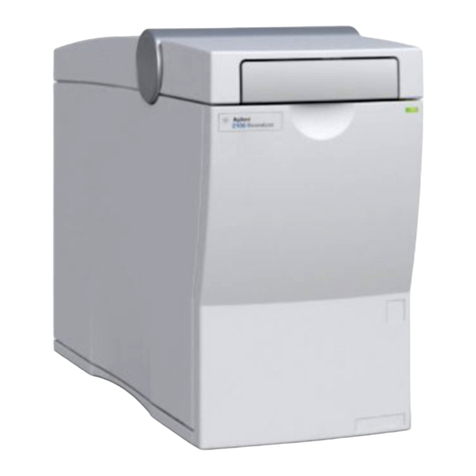
Agilent Technologies
Agilent Technologies 2100 Bioanalyzer System user guide
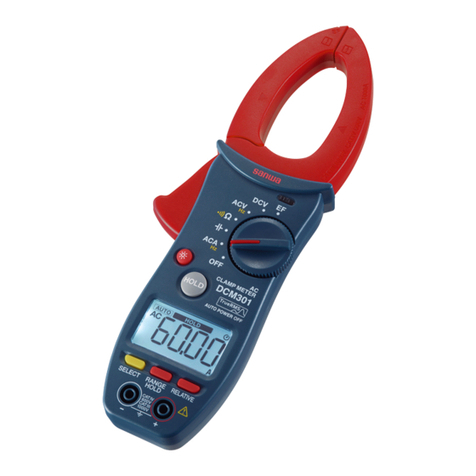
Sanwa
Sanwa DCM301 user manual

Boonton
Boonton PMX40 instruction manual
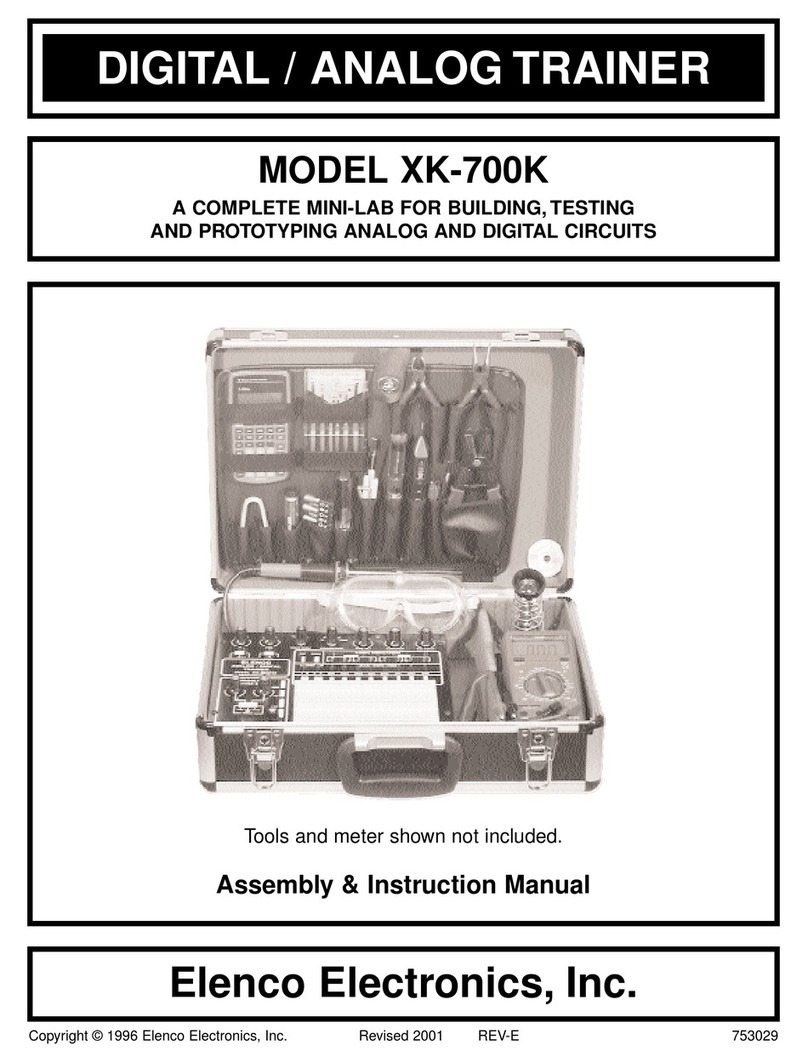
Elenco Electronics
Elenco Electronics XK-700K Assembly and instruction manual
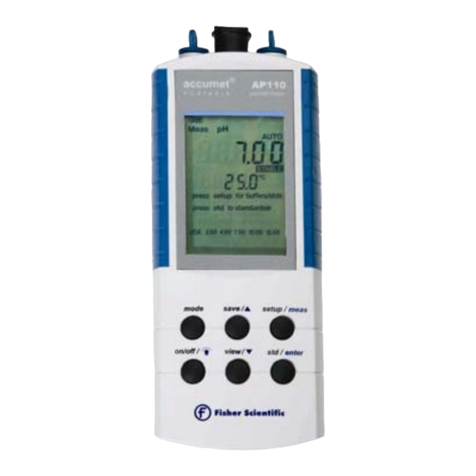
Fisher Scientific
Fisher Scientific accumet AP 110 accumet AP 115accumet AP 125 instruction manual
